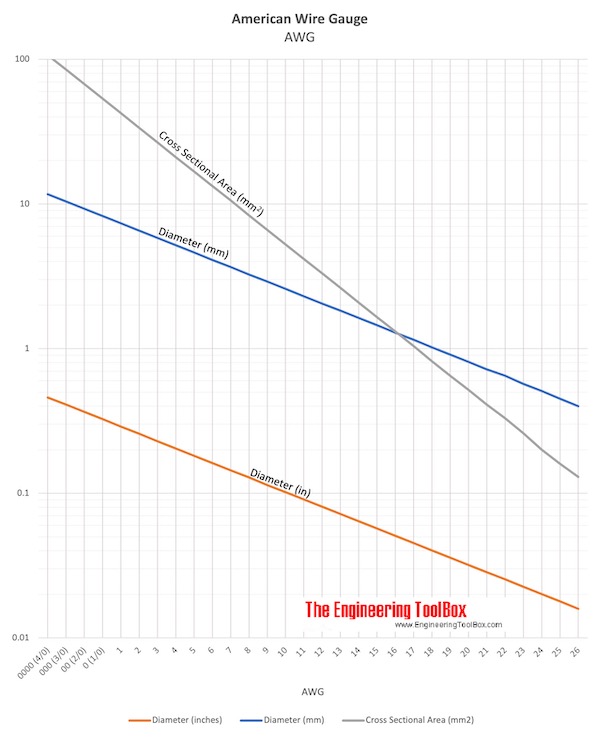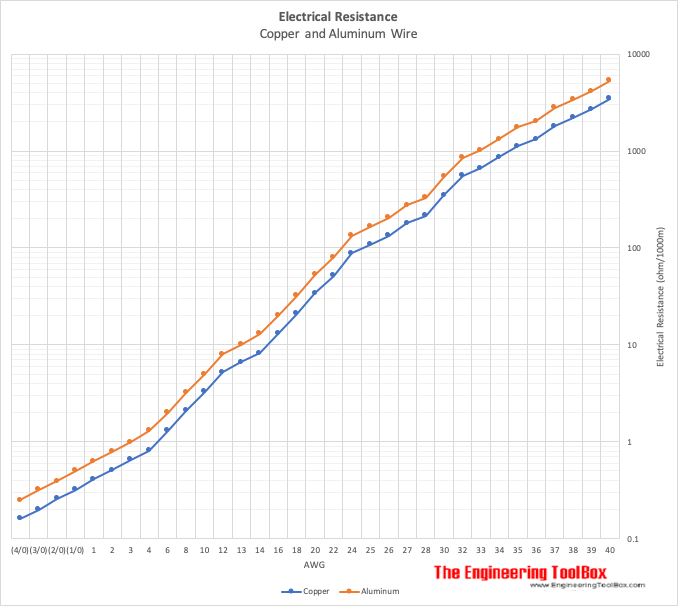How Many Amps Can 20 Gauge Wire Handle
The AWG - American Wire Approximate - is used as a standard method denoting wire diameter, measuring the diameter of the conductor (the blank wire) with the insulation removed. AWG is sometimes likewise known as Brownish and Sharpe (B&Due south) Wire Judge.
The AWG tabular array beneath is for a unmarried, solid, circular conductor. Considering of the small gaps between the strands in a stranded wire, a stranded wire with the same current-conveying chapters and electrical resistance as a solid wire, e'er accept a slightly larger overall bore.
The higher the number - the thinner the wire. Typical household wiring is AWG number 12 or 14. Telephone wire is typical AWG 22, 24, or 26.
The table below indicates the electric current ratings of PVC-insulated single and multicore wiring cables. Be aware that the current load depends on installation method - the enclosure - and how well the resistance heat is removed from the cable. Operating temperature of the conductor, ambience temperature and type of conductor insulation is important. E'er check the articles data earlier detailed engineering.
For full table with Unmarried Core and Multi Cadre Current Ratings - rotate the screen!
| AWG | Diameter (mm) | Diameter (in) | Square (mm2) | Resistance Copper (ohm/1000m) | Resistance Aluminum (ohm/1000m) | Typical Max. Current Load Ratings - Copper (amps) 1) | |||||
|---|---|---|---|---|---|---|---|---|---|---|---|
| Unmarried Core | Multicore | ||||||||||
| up to 3 cores | 4 - 6 cores | 7 - 24 cores | 25 - 42 cores | 43 and above | |||||||
| 40 | 0.08 | . | 0.0050 | 3448 | 5300 | ||||||
| 39 | 0.09 | . | 0.0064 | 2693 | 4141 | ||||||
| 38 | 0.ten | 0.0040 | 0.0078 | 2210 | 3397 | ||||||
| 37 | 0.11 | 0.0045 | 0.0095 | 1810 | 2789 | ||||||
| 36 | 0.13 | 0.0050 | 0.013 | 1326 | 2038 | ||||||
| 35 | 0.14 | 0.0056 | 0.015 | 1120 | 1767 | ||||||
| 34 | 0.sixteen | 0.0063 | 0.020 | 862 | 1325 | ||||||
| 33 | 0.18 | 0.0071 | 0.026 | 663 | 1019 | ||||||
| 32 | 0.20 | 0.0080 | 0.031 | 556 | 855 | ||||||
| thirty | 0.25 | 0.010 | 0.049 | 352 | 541 | ||||||
| 28 | 0.33 | 0.013 | 0.080 | 216 | 331 | ||||||
| 27 | 0.36 | 0.014 | 0.096 | 180 | 276 | ||||||
| 26 | 0.41 | 0.016 | 0.13 | 133 | 204 | ||||||
| 25 | 0.45 | 0.018 | 0.16 | 108 | 166 | ||||||
| 24 | 0.51 | 0.020 | 0.20 | 88 | 133 | 3.5 | 2 | 1.6 | 1.iv | ane.two | 1.0 |
| 22 | 0.64 | 0.025 | 0.33 | 52 | lxxx | five.0 | iii | two.four | two.1 | 1.8 | 1.5 |
| xx | 0.81 | 0.032 | 0.50 | 34 | 53 | 6.0 | 5 | 4.0 | three.v | 3.0 | 2.5 |
| 18 | 1.0 | 0.040 | 0.82 | 21 | 32 | 9.5 | 7 | 5.six | four.9 | iv.2 | 3.v |
| 16 | 1.3 | 0.051 | 1.3 | 13 | 20 | 15 | 10 | 8.0 | 7.0 | 6.0 | 5.0 |
| 14 | 1.six | 0.064 | 2.1 | viii.2 | xiii | 24 | 15 | 12 | 10 | ix.0 | vii.5 |
| 13 | 1.viii | 0.072 | 2.6 | six.6 | 10 | ||||||
| 12 | 2.1 | 0.081 | 3.3 | 5.2 | 8.0 | 34 | 20 | 16 | 14 | 12 | ten |
| 10 | 2.vi | 0.10 | 5.3 | 3.three | 5.0 | 52 | 30 | 24 | 21 | eighteen | 15 |
| 8 | 3.3 | 0.thirteen | 8.iii | ii.i | three.2 | 75 | twoscore | 32 | 28 | 24 | 20 |
| 6 | 4.1 | 0.17 | xiii.3 | i.3 | 2.0 | 95 | 55 | 44 | 38 | 33 | 27 |
| 4 | 5.2 | 0.20 | 21.ii | 0.81 | 1.3 | 120 | 70 | 56 | 49 | 42 | 35 |
| 3 | 26.vii | 0.65 | 0.99 | 154 | lxxx | 64 | 56 | 48 | twoscore | ||
| 2 | 6.five | 0.26 | 33.6 | 0.51 | 0.79 | 170 | 95 | 76 | 66 | 57 | 57 |
| 1 | seven.4 | 0.29 | 42.iv | 0.41 | 0.63 | 180 | 110 | 88 | 77 | 66 | 55 |
| 0 (ane/0) | eight.3 | 0.33 | 53.v | 0.32 | 0.l | 200 | |||||
| 00 (two/0) | 9.three | 0.37 | 67.4 | 0.26 | 0.39 | 225 | |||||
| 000 (three/0) | 10.four | 0.41 | 85.0 | 0.20 | 0.32 | 275 | |||||
| 0000 (four/0) | 11.7 | 0.46 | 107 | 0.16 | 0.25 | 325 | |||||
| 250 | 127 | 345 | |||||||||
| 300 | 152 | 390 | |||||||||
| 400 | 178 | 415 | |||||||||
1) Current ratings for up to m V, PVC-insulated single and multicore wiring cables, ambient temperature up to 30oC

Download and print AWG chart
Values for resistance are based on electric resistivity for copper 1.724 x ten-8 Ω m (0.0174 μΩ m) and electric resistivity for aluminum 2.65 x 10-8 Ω chiliad (0.0265 μΩ m).
- prefixes
The higher the judge number, the smaller the bore, and the thinner the wire.
Considering of less electrical resistance a thicker wire carries more current with less voltage driblet than a thinner wire. For longer distances information technology may be necessary to increase wire bore - reducing the gauge - to limit voltage drop.
Correction-factors at ambient temperature above 30oC
- ambient temperature 31 - xl oC: correction factor = 0.82
- ambience temperature 41 - 45 oC: correction factor = 0.71
- ambient temperature 45 - l oC: correction cistron = 0.58

Source: https://www.engineeringtoolbox.com/wire-gauges-d_419.html
Postar um comentário for "How Many Amps Can 20 Gauge Wire Handle"